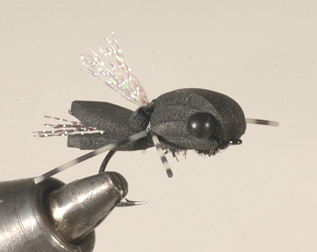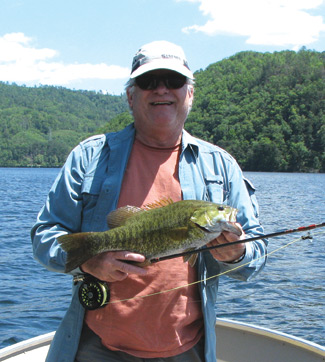My friend from Georgia, Kent Edmonds invented the Stealth Bomber, one of the best flies I have ever used for bass. His foam fly was designed for and works extremely well for many species of warmwater fish. We sell these flies. I use them often. I would not be fishing without having Kent’s Stealth Bombers in my boat bag or vest. A few years ago I started tying shorter Stealth Bombers. These flies didn’t have as much flash or the long tail and legs found on the original version. The tail was made from a few fibers of short bucktail. Jack Gregory and I found these less flashy flies worked well on the clear lakes where we fish for smallmouth bass. We used mostly black flies with solid black legs. We called them “Stillwater Bombers”. One day, 4 years ago, he and I caught 83 smallmouth bass, ranging from 1 pound to 5 pounds using these new Stealth Bombers. The smallmouth bass were sipping them off the surface. We returned the next week and caught over 60 in one day. We will probably never have another two days of fishing like that, ever.
I decided to come up with a similar design that would float higher in the water. That would require using 2 strips of 2mm foam instead of one. The new fly would not have the ability to dive like the Stealth Bomber. It would be more like a popper. Our smallmouth bass around here seem to like a dead drift better on the lakes or rivers at times. I tried all kinds of ideas. I would come up with something new at night, then take it down to Little River after work the next day to see what it looked like in the water. Some designs landed upside down often. I made changes in the design. I performed “drop tests” into a water vessel at home and counted how many times out of 100 the fly landed upside down. I spent the Winter of 2011 working on this design. I finally ended up with what you see here.
Over the course of December 2011 through March 2012 I tied over 300 of the flies to sell in the store. I wanted customers to use these flies on the rivers and lakes. I was hoping to get some feedback, either positive or negative and I did. My friends, Paula and I started fishing with them during 2012. Jack thought the foam tail was too long causing him to miss some bass. I shortened the tail.
In the beginning I was applying Zap-A-Gap where the mono eyes were inserted. Evidently, the CA glue made the eye stems brittle. Sometimes the eyes would break off. I stopped using the glue. The eyes stopped breaking. Many changes were made. So, far, the results are impressive. The best colors are black and chartreuse. I found a couple of flies on the internet named Knucklehead but they were not similar to this one at all. So, I named this fly Byron's Knucklehead to avoid confusion.
The Knuckleheads advantages are, they land light on the water, float high, they are easy to see and easy to tie. Bass, panfish and trout are attracted to them. They work. These flies are also very durable.




